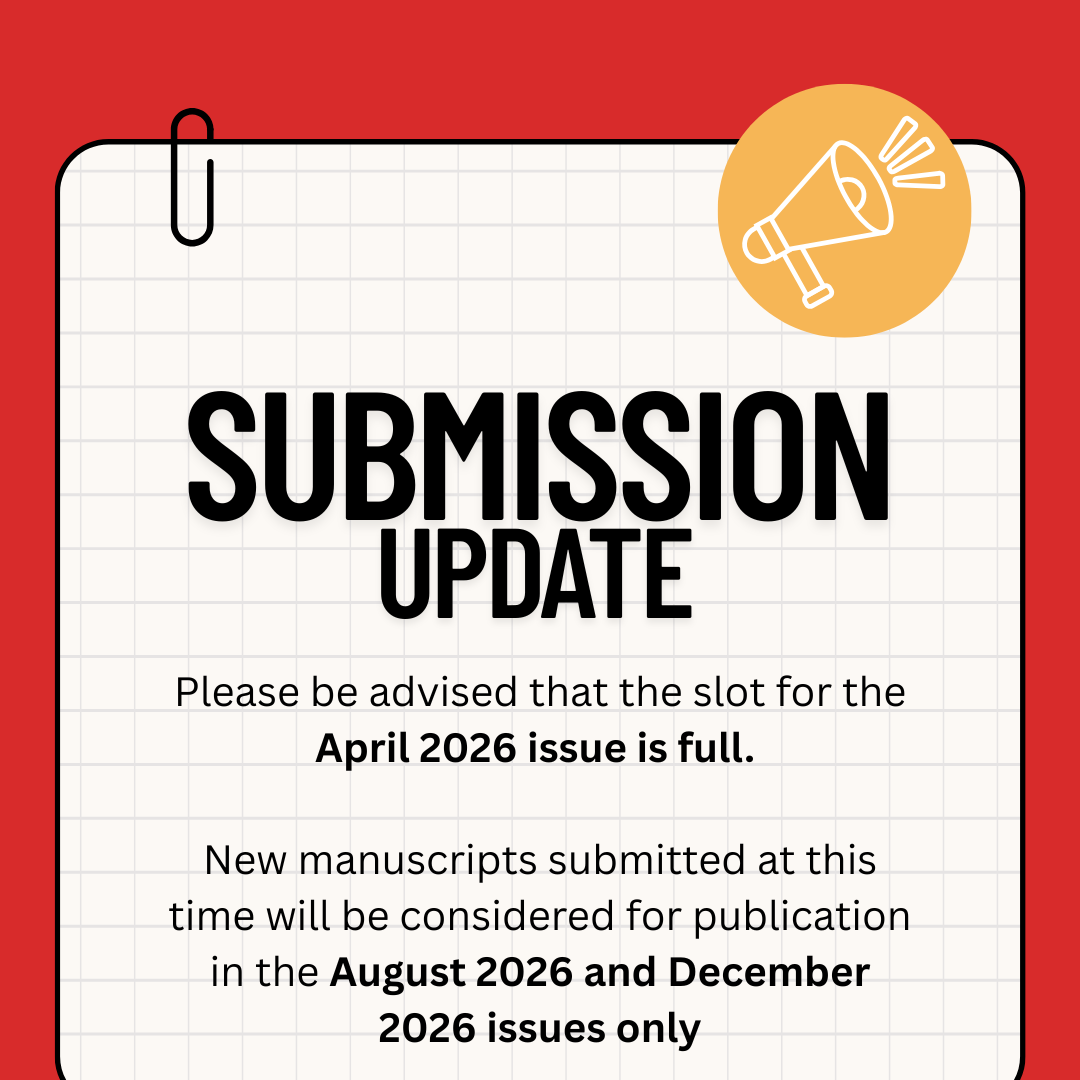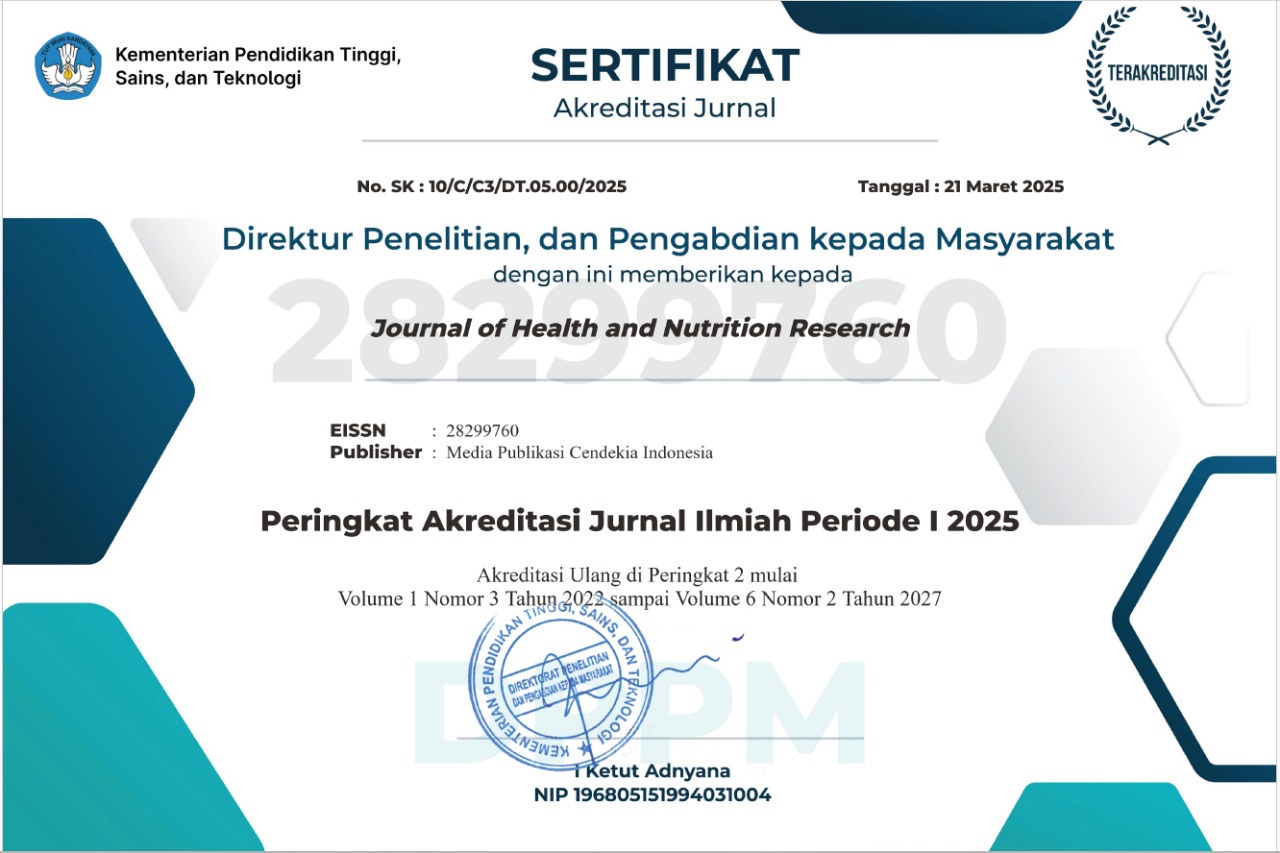Determinants of Risk for Type 2 Diabetes Mellitus Among the Community at The Birobuli Community Health Center
Keywords:
Physical Activity, Food Pattern, Sleep Quality, Dyslipidemia, Diabetes MellitusAbstract
To identify the determinants of risk for type 2 diabetes mellitus among the community at the Birobuli Community Health Center. Type of quantitative research with a case-control approach at a confidence level of 95%. The sample size was taken using the Slovin formula with a result of 76 people and a 1:1 ratio and using gender matching with a total sample of 152 people. Sampling was done using the purposive sampling technique. The data source used secondary data in the form of medical records and primary data in the form of interviews using questionnaires measuring physical activity, unhealthy eating patterns, and sleep quality with the criteria that a doctor diagnosed the respondent as suffering from Type 2 DM and not suffering from other types of Diabetes Mellitus (DM). Data analysis used the odds ratio test, the results showed that physical activity (OR=4.455 and CI=2.250-8.819), unhealthy eating patterns (OR=3.145 and CI=1.616-6.120), sleep quality (OR=5.444 and CI= 2,703 10,966), and dyslipidemia (OR=4,287 and CI=2,121-8,667) are determinants of the risk of Type 2 DM. It is suggested that health workers should improve health services at each Integrated Development Post (known as POSBINDU), an integrated monitoring and early detection activity for NCD risk factors (heart and blood vessel disease, diabetes, acute obstructive pulmonary disease, and cancer) as well as disorders due to accidents and acts of domestic violence which are managed by the community through integrated guidance, meanwhile, provide education on healthy lifestyles to overcome the incidence of DM
Downloads
References
Arifin H, Chou KR, Ibrahim K, Fitri SUR, Pradipta RO, Rias YA, et al. Analysis of Modifiable, Non-Modifiable, and Physiological Risk Factors of Non-Communicable Diseases in Indonesia: Evidence from the 2018 Indonesian Basic Health Research. J Multidiscip Healthc. 2022 Sep 30;15:2203–21.
Dilworth L, Facey A, Omoruyi F. Diabetes Mellitus and Its Metabolic Complications: The Role of Adipose Tissues. International Journal of Molecular Sciences. 2021 Jan;22(14):7644.
Fan W. Epidemiology in diabetes mellitus and cardiovascular disease. Cardiovasc Endocrinol. 2017 Feb 15;6(1):8–16.
Wild S, Roglic G, Green A, Sicree R, King H. Global prevalence of diabetes: estimates for the year 2000 and projections for 2030. Diabetes Care. 2004 May;27(5):1047–53.
IDF. IDF Diabetes Atlas, tenth. International Diabetes. 2021;
Kemenkes RI. Infodatin: Tetap Produktif, Cegah, dan Atasi Diabetes Melitus. 2020.
Kemenkes RI. Hasil Riset Kesehatan Dasar Tahun 2018. Kementrian Kesehatan RI. 2018.
Mirna E, Agus S, Asbiran N. Analisis Determinan Diabetes Melitus Tipe II Pada Usia Produktif di Kecamatan Lengayang Pesisir Selatan. Jurnal Public Health. 2020;7(1):30–42.
Prasetyani D, Sodikin S. Analisis Faktor Yang Mempengaruhi Kejadian Dm Melitus (Dm) Tipe 2. Jurnal Kesehatan Al-Irsyad. 2017;10(2):1–9.
Zulkarnaini A, Mahatma G, Puspita D, Vani AT, Abdullah D. Aktivitas Fisik, Pola Makan, dan Konsumsi Makanan Glikemik Tinggi Meningkatkan Risiko Kejadian Diabetes Mellitus Tipe 2. Jurnal Kesehatan Metro Sai Wawai. 2022;15(2):155–63.
Gordon BA, Benson AC, Bird SR, Fraser SF. Resistance training improves metabolic health in type 2 diabetes: a systematic review. Diabetes Res Clin Pract. 2009 Feb;83(2):157–75.
Suprianti AA, Masriadi M, Gobel FA. Determinan Diabetes Mellitus di Kabupaten Kepulauan Selayar. Journal of Muslim Community Health. 2023;4(4):120–9.
Rosita R, Kusumaningtiar DA, Irfandi A, Ayu IM. Aktivitas Fisik Lansia dengan Diabetes Melitus Tipe 2 di Puskesmas Balaraja Kabupaten Tangerang. Jurnal Kesehatan Masyarakat. 2022;10(3):364–71.
Sari SW, Adelina R. Apakah Pola Makan Menjadi Faktor Dominan Kejadian Diabetes Melitus Tipe 2 Di Indonesia? Jurnal Pangan Kesehatan dan Gizi Universitas Binawan. 2020 Dec 30;1(1):54–63.
Murtiningsih MK, Pandelaki K, Sedli BP. Gaya Hidup sebagai Faktor Risiko Diabetes Melitus Tipe 2. e-CliniC. 2021;9(2):328–33.
Sutanto IA. Perbedaan Indeks Glikemik Pada Nasi Putih (Oryza sativa), Ubi Cilembu (Ipomoea batatas cultivar cilembu) dan Ubi Ungu (Ipomoea batatas cultivar ayumurasaki) [Internet] [Thesis]. [Jember]: Universitas Jember; 2015 [cited 2024 Apr 6]. Available from: https://repository.unej.ac.id/xmlui/handle/123456789/68471
Amirah AD, Sumiaty, Ella Andayanie. Hubungan Pola Makan Dengan Kejadian Diabetes Melitus Pada Masyarakat Usia Di Atas 40 Tahun Di Kabupaten Gowa. Window of Public Health Journal. 2022;3(3):502–15.
Witek K, Wydra K, Filip M. A High-Sugar Diet Consumption, Metabolism and Health Impacts with a Focus on the Development of Substance Use Disorder: A Narrative Review. Nutrients. 2022 Jul 18;14(14):2940.
von Frankenberg A, Marina A, Song X, Callahan H, Kratz M, Utzschneider K. A high-fat, high-saturated fat diet decreases insulin sensitivity without changing intra-abdominal fat in weight-stable overweight and obese adults. European Journal of Nutrition. 2017 Feb 1;56(1):431–43.
Kimura Y, Yoshida D, Hirakawa Y, Hata J, Honda T, Shibata M, et al. Dietary fiber intake and risk of type 2 diabetes in a general Japanese population: The Hisayama Study. J Diabetes Investig. 2021 Apr;12(4):527–36.
Ginting NMCB, Mufidah PK. Kajian Pustaka: Kurangnya Kualitas Tidur Dapat Meningkatkan Risiko Kejadian Diabetes Melitus. Jurnal Biostatistik, Kependudukan, dan Informatika Kesehatan. 2021;1(3):189.
Tiajiwalar MS, Adnyana IGA, Pratiwi MRA. Hubungan Kualitas Tidur dengan Kadar Glukosa Darah Sewaktu pada Pasien Diabetes Melitus Tipe 2. Journal of Pharmaceutical and Health Research. 2023;4(1):134–40.
Alamer WM, Qutub RM, Alsaloumi EA, Natto NK, Alshehri RM, Khafagy A. Prevalence of Sleep Disorders Among Patients With Type 2 Diabetes Mellitus in Makkah City: A Cross-Sectional Study. Cureus. 2022;14(12):e33088.
Mesarwi O, Polak J, Jun J, Polotsky VY. Sleep disorders and the development of insulin resistance and obesity. Endocrinol Metab Clin North Am. 2013 Sep;42(3):617–34.
Garbarino S, Lanteri P, Bragazzi NL, Magnavita N, Scoditti E. Role of sleep deprivation in immune-related disease risk and outcomes. Commun Biol. 2021 Nov 18;4(1):1–17.
Grandner MA, Seixas A, Shetty S, Shenoy S. Sleep Duration and Diabetes Risk: Population Trends and Potential Mechanisms. Curr Diab Rep. 2016 Nov;16(11):106.
Hagen EW, Starke SJ, Peppard PE. The Association Between Sleep Duration and Leptin, Ghrelin, and Adiponectin Among Children and Adolescents. Curr Sleep Medicine Rep. 2015 Dec 1;1(4):185–94.
Nollet M, Wisden W, Franks NP. Sleep deprivation and stress: a reciprocal relationship. Interface Focus. 2020 Jun 6;10(3):20190092.
Kita T, Yoshioka E, Satoh H, Saijo Y, Kawaharada M, Okada E, et al. Short Sleep Duration and Poor Sleep Quality Increase the Risk of Diabetes in Japanese Workers With No Family History of Diabetes. Diabetes Care. 2012 Feb;35(2):313–8.
Lestari A, Handini MC, Sinaga TR. Faktor Risiko Kejadian Dislipidemia Pada Lansia. Jurnal Riset Hesti Medan. 2018;3(2):16–26.
Wahidah N, Rahayu SR. Determinan Diabetes Melitus pada Usia Dewasa Muda. Higeia Journal of Public Health Research and Development. 2022;6(1):114–25.
Martín-Timón I, Sevillano-Collantes C, Segura-Galindo A, del Cañizo-Gómez FJ. Type 2 diabetes and cardiovascular disease: Have all risk factors the same strength? World J Diabetes. 2014 Aug 15;5(4):444–70.
Cannon CP. Mixed dyslipidemia, metabolic syndrome, diabetes mellitus, and cardiovascular disease: clinical implications. Am J Cardiol. 2008 Dec 22;102(12A):5L-9L.
Bonilha I, Zimetti F, Zanotti I, Papotti B, Sposito AC. Dysfunctional High-Density Lipoproteins in Type 2 Diabetes Mellitus: Molecular Mechanisms and Therapeutic Implications. J Clin Med. 2021 May 21;10(11):2233.
Pratiwi WR, Hediningsih Y, Isworo JT. Hubungan Kadar Glukosa Darah Dengan Kadar Hdl (High Density Lipoprotein) Pada Pasien Diabetes Melitus Tipe 2. Jurnal Labora Medika. 2021;5:29–34.
Nizar M, Amelia R. Hubungan Kadar Trigliserida Dengan Indeks Masa Tubuh Pada Penderita Diabetes Melitus Tipe 2 di RS Krakatau Medika. Journal of Medical Laboratory Research. 2022;1(1):7–12.
Garbuzova EV, Shcherbakova LV, Rymar OD, Khudiakova AD, Shramko VS, Ragino YI. Triglycerides, Obesity and Education Status Are Associated with the Risk of Developing Type 2 Diabetes in Young Adults, Cohort Study. J Pers Med. 2023 Sep 19;13(9):1403.
Published
How to Cite
Issue
Section
Copyright (c) 2024 Muh. Jusman Rau, Nurjannah Nurjannah, Dilla Srikandi Syahadat, Hasanah Hasanah

This work is licensed under a Creative Commons Attribution-NonCommercial-ShareAlike 4.0 International License.
Most read articles by the same author(s)
- Muhammad Ryman Napirah, Vidyanto Vidyanto, Heru Kukuh Prayitno, Hasanah Hasanah, Nur Mila Sari, Rasyika Nurul Fadjriah, The Relationship Between Situational Leadership Style and Motivation with Employee Performance at Kamonji Community Health Center in West Palu District, Palu City , Journal of Health and Nutrition Research: Vol. 3 No. 3 (2024)
- Kiki Sanjaya, Pitriani Pitriani, Putri Trisnowati, Febi Dwi Handayani, Muh. Jusman Rau, Hermiyanty Hermiyanty, The Effect of Climate Change on Environmental-Based Diseases in Palu City in 2015-2020 , Journal of Health and Nutrition Research: Vol. 1 No. 1 (2022)
- Marselina Palinggi, Muh. Jusman Rau, Nur Hikma Buchair, Annisa Raudhatul Jannah, Rahmania, Moh. Fikram Dg Sirata, Factors Associated with Decreasing Incidence of Stunting in the Working Area of the Palu Health Center , Journal of Health and Nutrition Research: Vol. 2 No. 1 (2023)
- Dilla Srikandi Syahadat, Ni Made Eviyulianti, Muh. Jusman Rau, Elvaria Mantao, Sendhy Krisnasari, The Risks of Sexual and Reproductive Activity on the Occurrence of Cervical Cancer in Central Sulawesi Province: Case Study of patients of Undata Hospital , Journal of Health and Nutrition Research: Vol. 1 No. 3 (2022)
- Sitti Radhiah, Nur Khairul Fatassya, Hasanah Hasanah, Elvaria Mantao, Risk Factor for Postpartum Hemorrhage in The Post-Disaster (2019-2021) , Journal of Health and Nutrition Research: Vol. 2 No. 3 (2023)
- Sendhy Krisnasari, Tresia Aulia, Dilla Srikandi Syahadat, Marsellina Marsellina, Bertin Ayu Wandira, The Relationship of Environmental Factors and Nutritional Status and The Incidence of ARI of Toddler in the Working Area of Donggala Public Health Center , Journal of Health and Nutrition Research: Vol. 1 No. 1 (2022)
- Hasanah, Muafiah Basir, Herawanto, Muh. Jusman Rau, Factors Influencing the Discovery of Suspected Tuberculosis during the COVID-19 Pandemic in Palu City , Journal of Health and Nutrition Research: Vol. 1 No. 3 (2022)



















